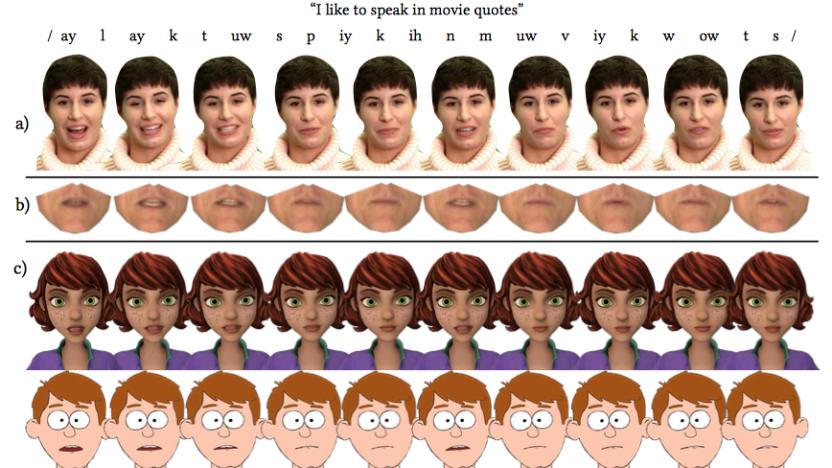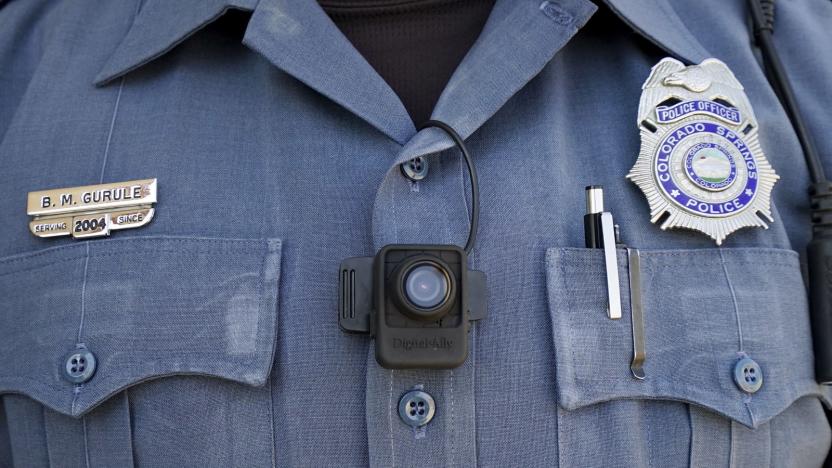carnegiemellonuniversity
Latest

Facebook and CMU's poker AI beat five pros at once
Facebook and Carnegie Mellon University have built another artificial intelligence bot that beat some top poker pros. While AI bots have been to best professional players in one-on-one competition, Facebook claims it's the first time a bot has been able to beat top pros in "any major benchmark game" when there's more than one opponent at a time. Pluribus bested professionals in no-limit Texas Hold'em in a couple of different formats: five AI bots and one human, and one bot and five real-life players. The researchers behind Pluribus wrote in a paper published in Science that creating such a multiplayer poker bot "is a recognized AI milestone."

Researchers develop method for real-time speech animation
Researchers at the University of East Anglia, Caltech, Carnegie Mellon University and Disney have created a way to animate speech in real-time. With their method, rather than having skilled animators manually match an animated character's mouth to recorded speech, new dialogue can be incorporated automatically in much less time with a lot less effort.

Scientists release huge set of exoplanet-detecting observations
If you've always wanted to find exoplanets, now's your chance to help. A team of scientists from MIT, Carnegie Mellon and other universities have released a huge dataset containing 61,000 individual measurements of more than 1,600 nearby stars. All the measurements came from two decades of observations made by the HiRES spectrometer, which is mounted on a 33-foot telescope at the Keck Observatory in Hawaii, using a technique called radial velocity method. Simply put, the scientists used the tool to detect the tiny wobble stars make in response to the gravity of an orbiting planet. Thus, the dataset contains the date, the star's velocity, the error on that velocity and measurements of its activity during that observation.

How an AI took down four world-class poker pros
"That was anticlimactic," Jason Les said with a smirk, getting up from his seat. Unlike nearly everyone else in Pittsburgh's Rivers Casino, Les had just played his last few hands against an artificially intelligent opponent on a computer screen. After his fellow players -- Daniel McAulay next to him and Jimmy Chou and Dong Kim in an office upstairs -- eventually did the same, they started to commiserate. The consensus: That AI was one hell of a player.

Can big data and AI fix our criminal-justice crisis?
America, land of the free. Yeah, right. Tell that to the nearly 7 million people incarcerated in the US prison system. The United States holds the dubious distinction of having the highest per capita incarceration rate of any nation on the planet -- 716 inmates for every 100,000 population. We lock up more of our own people than Saudi Arabia, Kazakhstan or Russia. And once you're in, you stay in. A 2005 study by the Bureau of Justice Statistics (BJS) followed 400,000 prisoners in 30 states after their release and found that within just three years, more than two-thirds had been rearrested. That figure rose to over 75 percent by 2010.

Disney Research uses RFID tags for low-cost interactive games
Disney Research and Carnegie Mellon University have developed a way to use RFID tags to make interactive games and controllers so cheap, they're "essentially disposable." Their system called "RapID" can sense if you're moving or touching objects attached with cheap, battery-less RFID tags in near real time. RFID readers typically take up to two seconds to read tags on luggage or other items, but RapID can recognize movements in as little as 200 milliseconds.

Helicopter and six-wheeler make a mean, crewless recon team
Why send humans into dangerous territory when you can send unmanned helicopters and six-wheelers instead? In an impressive mashup of autonomous transportation, Carnegie Mellon University (CMU) and aircraft manufacturer Sikorsky have shown the two vehicles working together without on-board operators. During the demonstration, a modified Black Hawk helicopter picks up a chunky Land Tamer with a large cage, before flying 12 miles and releasing it at a designated drop-zone. The ground vehicle then navigates the leafy terrain for six miles, with a remote driver occasionally chipping in to explore particularly hazardous sites.

Facebook is opening an Oculus research office in Pittsburgh
Facebook is about to open a facility dedicated to Oculus virtual reality research in Pittsburgh. The company confirmed the news to Venture Beat after a local paper noticed that it had leased a 20,000 square foot building in the city's Oakland neighborhood. Why Steeltown, you might ask? Facebook, which purchased Oculus in 2014, is attracted by the large pool of research talent coming out of Carnegie Mellon University and other local schools. In fact, It has already posted job listings for computer vision engineers, programmers and post-doctoral researchers. Those fields of expertise are also vital for self-driving cars, which is why Uber (and reportedly Apple) recently set up shop in the city.

Carnegie Mellon may have ratted out Tor users to the FBI
In a story that may become an acid test for internet privacy, the operators of the Tor network have accused Carnegie Mellon University (CMU) of taking up to $1 million to help the FBI bust illegal sites. If the allegations are true, the defendants in question certainly had it coming -- they include the drug market Silk Road 2.0 and a child pornographer. However, Tor director Roger Dingledine questions the university's ethics in the attack. "We think it's unlikely they could have gotten a valid warrant ... [since it] appears to have indiscriminately targeted many users at once," he said.

3D printing hair is as easy as using a hot glue gun
Researchers at Carnegie Mellon University have devised an ingenious method for creating lifelike hair fibers the only requires a common, inexpensive fused deposition modeling (FDM) printer. The technique is surprisingly simple: the printer squeezes out a small dollop of molten plastic and then pulls away, stretching the material into a long strand -- much like the sticky strings that hot glue guns leave behind.

Scientists stretch metal to make it stronger
You'd think that stretching metal would make it weaker, but just the opposite is true... on a very small scale. Researchers have developed a technique that pulls nanoscopic metal crystals to eliminate defects. By gently and repeatedly stretching the crystal, scientists move "dislocations" (rows of atom-level defects) to free surfaces, where they're ultimately forced out. The result is a metal that is considerably less likely to crack or otherwise fail over time.

The bots that bucked the humanoid trend at DARPA's challenge
#fivemin-widget-blogsmith-image-897542{display:none;} .cke_show_borders #fivemin-widget-blogsmith-image-897542, #postcontentcontainer #fivemin-widget-blogsmith-image-897542{width:570px;display:block;} try{document.getElementById("fivemin-widget-blogsmith-image-897542").style.display="none";}catch(e){} Humanoids are supposed to be best suited for a world that's engineered for humans. They can climb stairs, open doors and drive cars. At DARPA Robotics Challenge, most of the participating humanoids succeeded in completing those tasks, but when it came to walking, they were clumsier than the species they were designed to emulate. Getting a machine to put one foot in front of the other has been a priority for roboticists for decades. Bipedal locomotion would presumably make it easier for robots to navigate a man-made world and perhaps make them more relatable. But the movement requires sophisticated control software and advanced AI technology that isn't quite ready yet.

Uber poached Carnegie Mellon's robotics lab to make self-driving cars (updated)
Remember how Uber forged a partnership with Carnegie Mellon University to get its ambitions for self-driving cars off the ground? It turns out this deal wasn't exactly balanced. The Verge understands that Uber poached much of the autonomous vehicle team from Carnegie Mellon's robotics lab, including top staff who'd been there for more than a decade. There's a transition period that keeps these researchers around to finish existing work, but the rash of departures is reportedly creating a vacuum at the school -- and it's not clear if those soon-to-depart people are working on academic projects or Uber technology.

Watch a dome full of cameras capture 3D motion in extreme detail
Conventional 3D motion capture is awkward; even if you don't mind people covered with dots or ping pong balls, you often get just a handful of data points that miss out on subtle movements. Researchers at Carnegie Mellon University might just have a more elegant solution in store, though. They've built a geodesic dome whose 480 cameras work in concert to track a whopping 100,000 points without the need for markers. The system uses its abundance of video footage to estimate trajectories based on changes in light, motion and shape, rather than looking for arbitrary cues or interpolating image frames. As you can see in the clips below, the resulting data is both vividly detailed and natural-looking -- you can see individual confetti flakes falling to the ground, and it's easy to follow every nuance of a batter's swing.

Carnegie Mellon computer learns common sense through pictures, shows what it's thinking
Humans have a knack for making visual associations, but computers don't have it so easy; we often have to tell them what they see. Carnegie Mellon's recently launched Never Ending Image Learner (NEIL) supercomputer bucks that trend by forming those connections itself. Building on the university's earlier NELL research, the 200-core cluster scours the internet for images and defines objects based on the common attributes that it finds. It knows that buildings are frequently tall, for example, and that ducks look like geese. While NEIL is occasionally prone to making mistakes, it's also transparent -- a public page lets you see what it's learning, and you can suggest queries if you think there's a gap in the system's logic. The project could eventually lead to computers and robots with a much better understanding of the world around them, even if they never quite gain human-like perception.

Study: Facebook users sharing more personal info despite increased privacy concerns
Carnegie Mellon University conducted a study following more than 5,000 Facebook users over six years, from 2005 and 2011, and found that changes in the social network's privacy policies caused users to share more -- not less -- personal data. Lest you think this means that users suddenly trusted the site more, Carnegie Mellon says that Facebookers became more and more protective of their personal details as the social network grew in membership -- and that the uptick in shared information is a result of increasingly granular privacy settings. If you recall, Facebook introduced new in-depth privacy controls in 2010, and the study found that the release of these new settings corresponded to users sharing more personal data, both within their network of friends and with strangers and third-party applications. It's been quite some time since the new privacy policy was introduced, but the university says the sample group didn't reduce the amount of info shared with non-friends on the network, even as of 2011. The takeaway? Well, it's safe to say that more privacy controls doesn't equal more vigilance in protecting personal data, and it's certainly not a stretch to call Facebook's settings confusing. The researchers' comparison of the struggle for privacy to the eternal plight of Sisyphus? That might be a touch more dramatic.

Robot Hall of Fame inducts Big Dog, PackBot, Nao and WALL-E (video)
It's the sort of ceremony that's so magical it can only occur on even-numbered years. Inventors, educators, entertainers, college students and media folk gathered at the Carnegie Science Center in Pittsburgh, PA tonight for the 2012 inductions to the Robot Hall of Fame, a Carnegie Mellon-sponsored event created to celebrate the best of our mechanical betters. This year, the field included four categories, judged by both a jury of 107 writers, designs, entrepreneurs and academics and the public at large, each faction constituting half the voting total. The show kicked off, however, with the induction of 2010 winners, the Spirit and Opportunity Mars rovers, the da Vinci Surgical System, iRobot's Roomba, the Terminator and Huey, Dewey and Louie, a trio of robots from 1971's Silent Running. The first 'bot to secure its spot in the class of 2012, was the programmable humaoid Nao, from Aldebaran Robotics, which beat out the iRobot Create and Vex Robotics Design System in the Educational category. The PackBot military robot from iRobot took the Industrial and Service category, beating out the Kiva Mobile Robotic Fulfillment System and Woods Hole Oceanographic's Jason. Boston Dynamic's Big Dog ran over some stiff competition in the form of Willow Garage's PR2 and NASA's Robonaut to win the Research title. And WALL-E triumphed over doppelganger Johnny Five and the Jetsons' Rosie in the Entertainment category. Relive the festivities in four minutes after the break.

Acoustic barcodes store data in sound, go on just about anything (video)
Technologies like NFC, RFID and QR codes are quickly becoming a normal part of everyday life, and now a group from Carnegie Mellon University has a fresh take on close-quarters data it calls acoustic barcodes. It involves physically etching a barcode-like pattern onto almost any surface, so it produces sound when something's dragged across it -- a fingernail, for example. A computer is then fed that sound through a microphone, recognizes the waveform and executes a command based on it. By altering the space between the grooves, it's possible to create endless unique identifiers that are associated with different actions. It's easy to see how smartphones could take advantage of this -- not that we recommend dragging your new iPhone over ridged surfaces -- but unlike the technologies mentioned earlier, not all potential applications envisage a personal reading device. Dot barcodes around an area, install the sound processing hardware on site, and you've got yourself an interactive space primed for breaking freshly manicured nails. We're pretty impressed by the simplicity of the concept, and the team does a good job of presenting scenarios for implementing it, which you can see in the video below. And, if you'd like to learn a little more about the idea or delve into the full academic paper, the source links await you. [Thanks, Julia]

Polaris rover will travel to the Moon in search of polar resources, try to survive the long lunar night
The Polaris rover may look a little punk rock, but that mohawk is no fashion statement. It's for catching solar rays which shine almost horizontally at the Moon's north pole, a location Polaris is due to explore before 2016. Built by Astrobotic Technology, it'll be ferried aboard the SpaceX Falcon 9 rocket to our celestial companion, where it'll drill into the surface in search of ice. The company, spun out of the Carnegie Mellon University, hopes to identify resources at a depth of up to four feet that could be used to support manned Moon expeditions in the future. The plan is to complete the mission during a 10-day window of sunlight, digging at up to 100 sites over a three-mile stretch. However, if it can live through the harsh two-week-long nights, then it may continue to operate "indefinitely." NASA is backing the project, providing ice-prospecting gear and money, although Astrobotic hopes to get more cash for its work -- over $20 million from Google's Lunar X Prize. Right now, Polaris is a flight prototype and there are still improvements to be made, mainly on the software side, before it tackles the rough terrain. Check out the short video of its public unveiling below, although we don't think the soundtrack quite matches the hairdo.

Robot Hall of Fame voting begins for class of 2012, Johnny 5 learns where BigDogs sit
It's that time again: time for Carnegie Mellon to roll out the red carpet and welcome the crème de la crème of the robotics world into its halls. Since 2003 the school has been selecting the best of the best and inducting them into the Robot Hall of Fame. Past honorees have included everything from LEGO Mindstorms to the Terminator. This year's list of nominees is no less impressive, with celebrity bots Johnny 5 and WALL-E pitted against each other in the entertainment category, while NASA's Robonaut takes on the PR2 and BigDog under the banner of research bots. There will also be two other inductees awarded a spot in the hall in the consumer and education category and the industrial and service field. Best of all, for the first time ever, Carnegie Mellon is letting the public vote on the inductees. And, while PETMAN was snubbed yet again, he's not letting that get him down -- the Boston Dymanic's biped just keeps on struttin'. Hit up the source link to cast your vote before the September 30th deadline and check back on October 23rd to see who's granted a podium speech.












